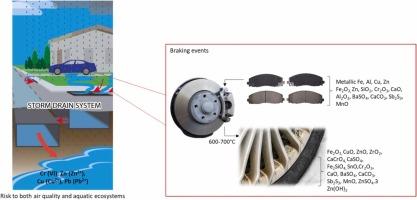车辆非排气颗粒物质中金属的形态和流动性
IF 11.3
1区 环境科学与生态学
Q1 ENGINEERING, ENVIRONMENTAL
引用次数: 0
摘要
由于尾气排放减少以及轮胎和刹车磨损造成的高金属负荷,非排气车辆颗粒物排放(NEVPM)在空气质量政策中越来越重要。新能源pm成分一旦沉积,就会被雨水调动,造成城市水污染。本研究考察了轮胎、刹车片(bp)和刹车粉尘的化学成分。对刹车片进行热处理以模拟制动温度,并对处理后的bp和制动粉尘进行浸出测试,以评估金属释放和形态。轮胎配方显示出一致的碳含量和无机添加剂,而bp由复杂的矿物相组成,具有可变的Al, Fe, Ti, Cu和微量金属。热处理引起矿物学转变,包括金属氧化物和硫酸盐的氧化和形成,改变金属的流动性和生物利用度。浸出试验显示有毒金属释放,特别是锌、铜、铅、锰、铬(VI)和砷,经常超过规定的阈值。治疗后Cr(VI)形成增加,强调健康风险。制动粉尘中主要含有含有Fe氧化物、Cu、Zn、Ba、Sb等微量元素的细颗粒物,凸显了制动磨损是城市主要污染源。这些发现强调轮胎和刹车碎片是重要的金属污染源,强调需要更严格的监管控制和更安全的材料配方。本文章由计算机程序翻译,如有差异,请以英文原文为准。

Speciation and mobility of metals from vehicular non-exhaust particulate matter
Non-exhaust vehicle particulate matter emissions (NEVPM) are gaining prominence in air quality policies due to reduced exhaust emissions and the high metal load from tyre and brake wear. Once deposited, NEVPM components can be mobilised by rainwater, contributing to urban water contamination. This study examines the chemical composition of tyres, brake pads (BPs), and brake dust. Brake pads were thermally treated to simulate braking temperatures, and both treated BPs and brake dust underwent leaching tests to assess metal release and speciation. Tyre formulations showed consistent carbon content and inorganic additives, whereas BPs comprised complex mineral phases with variable Al, Fe, Ti, Cu, and trace metals. Thermal treatment induced mineralogical transformations, including oxidation and formation of metal oxides and sulphates, altering metal mobility and bioavailability. Leaching tests revealed toxic metal releases, particularly Zn, Cu, Pb, Mn, Cr(VI), and As, often exceeding regulatory thresholds. Cr(VI) formation increased post-treatment, underscoring health risks. Brake dust predominantly contained fine PM enriched with Fe oxides, Cu, Zn, Ba, Sb, and other trace elements, highlighting brake wear as a major urban pollution source. These findings emphasise tyre and brake debris as significant metal pollution sources, underscoring the need for stricter regulatory controls and safer material formulations.
求助全文
通过发布文献求助,成功后即可免费获取论文全文。
去求助
来源期刊

Journal of Hazardous Materials
工程技术-工程:环境
CiteScore
25.40
自引率
5.90%
发文量
3059
审稿时长
58 days
期刊介绍:
The Journal of Hazardous Materials serves as a global platform for promoting cutting-edge research in the field of Environmental Science and Engineering. Our publication features a wide range of articles, including full-length research papers, review articles, and perspectives, with the aim of enhancing our understanding of the dangers and risks associated with various materials concerning public health and the environment. It is important to note that the term "environmental contaminants" refers specifically to substances that pose hazardous effects through contamination, while excluding those that do not have such impacts on the environment or human health. Moreover, we emphasize the distinction between wastes and hazardous materials in order to provide further clarity on the scope of the journal. We have a keen interest in exploring specific compounds and microbial agents that have adverse effects on the environment.
 求助内容:
求助内容: 应助结果提醒方式:
应助结果提醒方式:


